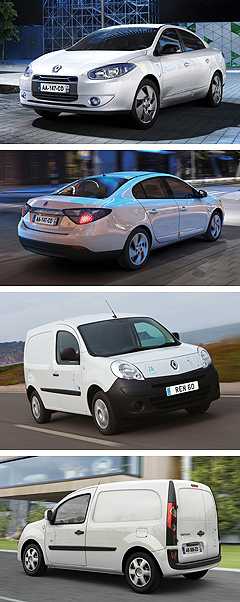Only one Renault EV designed for battery swap
BY RON HAMMERTON | 22nd Aug 2012

The Renault Fluence ZE – based on the Fluence small sedan already on sale here – has been designed to accept the drop-out lithium-ion battery pack developed in league with vehicle charging company Better Place.
The Fluence ZE is scheduled to arrive in Australia late this year, making its debut with a toe-in-the water trial in Canberra before being progressively rolled out across the country from Melbourne.
However, Renault appears to have gone cold on the battery swap system, designing its next-generation models with fixed battery systems - at least for launch variants – like other mass EV producers.
The next EV from Renault – the Zoe five-door hatchback city car due in Australia in early 2014 – has been designed for fixed batteries, like the permanent lithium-ion pack in the Nissan Leaf with which it shares technology.
As well, the Renault Kangoo ZE small electric-powered van that is under consideration for Australia also has been engineered for permanent batteries, at least at this stage.
Apart from the Fluence ZE and seven government-funded, experimental electric Holden Commodores built by Melbourne-based EV Engineering – of which Better Place is a supporter – no other vehicles with exchangeable battery systems appear to be on the horizon.

Renault Australia managing director Justin Hocevar said at this week's Megane RS265 launch in Brisbane that the Fluence ZE could be charged in the same way as a fixed battery car, or, if a battery swap station was nearby, as a quick-change EV under a contract with a battery-swap provider.
Fluence ZE drivers would pay a service fee to the charging company to supply freshly charged batteries that could be exchanged for the depleted cells in less time than it takes to refuel a petrol or diesel car, instead of spending up to eight hours charging.
But Mr Hocevar conceded that Fluence EV sales in Australia were expected to be small, in line with the modest volumes sold by partner Nissan and rival Mitsubishi to date.
He said the next Renault EV destined for Australia, the 2014 Zoe, had much greater potential for volume sales as it had been designed from the ground up as an electric car, with considerable benefits in performance, range and packaging.
“I expect Zoe to be the most important model in our EV range,” he said.
The Zoe, which was tested by Renault engineers in Australia earlier this year, was conceived as a low-cost EV, with a potential range of up to 210km on a full charge – the most of any European-built mass-produced EV to date.
Renault expects the Clio-sized Zoe to be the world's best-selling EV within three years.
Sharing powertrain items with the Nissan Leaf, the Zoe has not been engineered with a battery pack that drops from under the car, in the same way as Fluence ZE.
The exchange system apparently requires a precision design to enable the automated battery swap system, along with special electronics to link the battery pack with the electric drive system.
No battery swap stations have opened yet in Australia, although Better Place has committed to supporting the Fluence ZE roll-out in Canberra and then other cities.
Mr Hocevar was highly critical of the lack of Australian government support for electric vehicles, saying Europe and even China offered significant incentives to car buyers to go electric.
“I had hoped that Australia would at least move with the rest of the world on this, but we are way behind,” he said.
“We have taken a world-leading stance on the carbon tax, but not on this. Not even the Green Party has a policy for this.” The Zoe is expected to go into right-hand drive production for the UK late next year, paving the way for shipments of similar vehicles to Australia in early 2014.
While the Fluence ZE (Zero Emission) will be touted as the first all-electric family sedan on the Australian market, the Zoe will be offered at a considerable cost saving and aimed at city commuters for whom the range restrictions of electric cars hold fewer fears.
Like the Fluence ZE, the Kangoo ZE is a modified version of an existing internal-combustion vehicle.
Despite early reports that the Kangoo ZE would get the replaceable battery pack system, the vehicle has been built only with fixed batteries requiring charging at a charging station or on a home plug.
However, Renault says it has not ruled out building some vehicles with swap batteries at a later date.
Mr Hocevar said no decision had been made on the Kangoo ZE for Australia, saying the business case was still to be made.
But he ruled out Renault's other all-electric offering, the Twizy, saying it could not meet Australian design rules.
Twizy resembles a cross between an electric motorcycle and a car – a category not catered for under Australian vehicle laws.